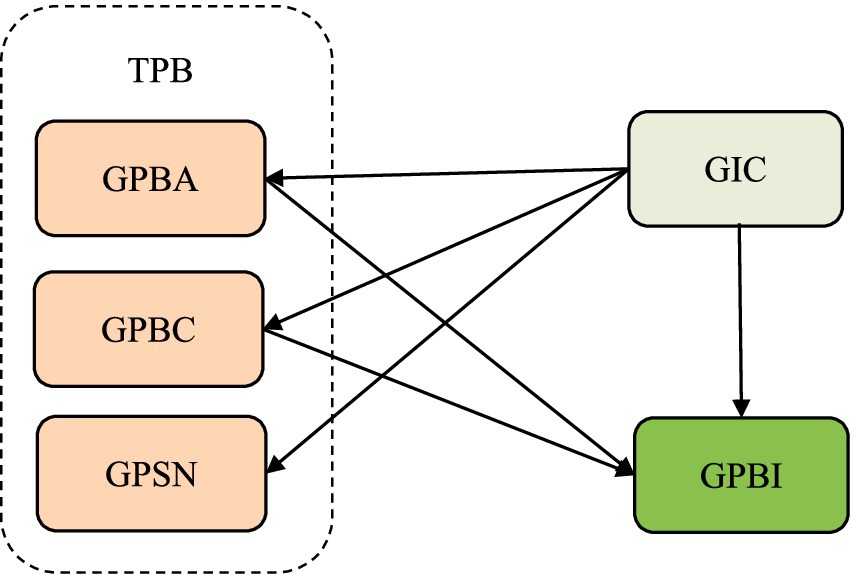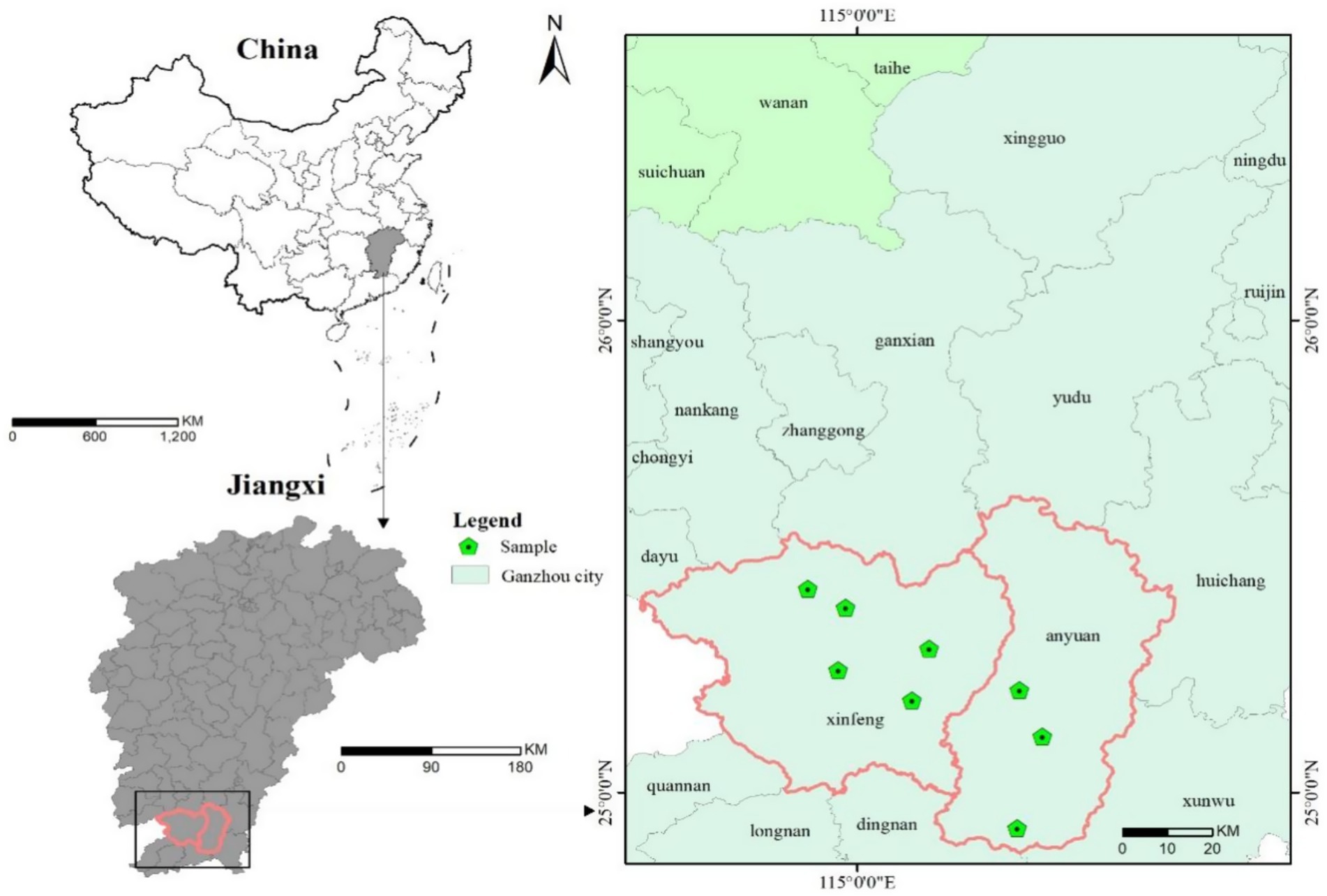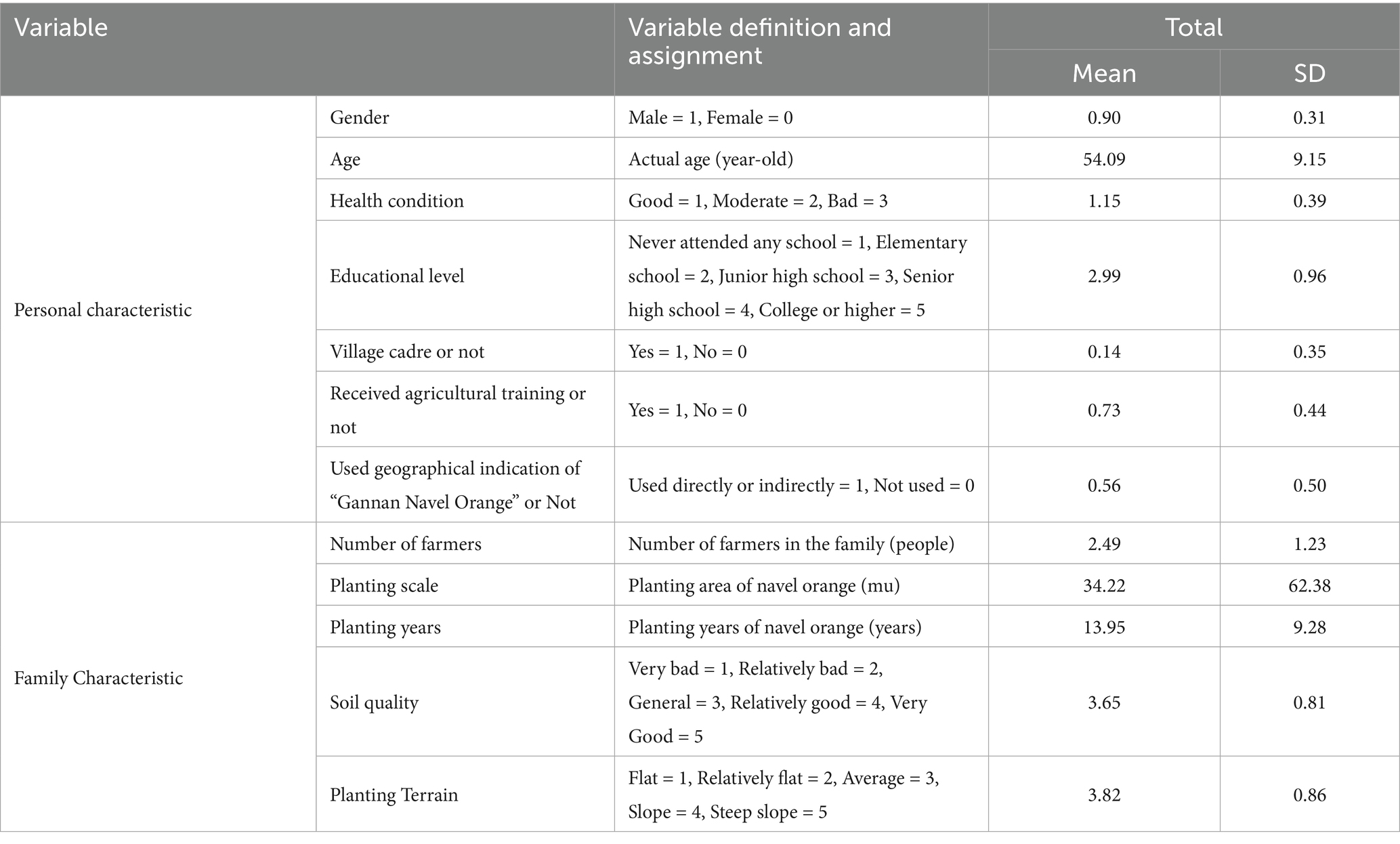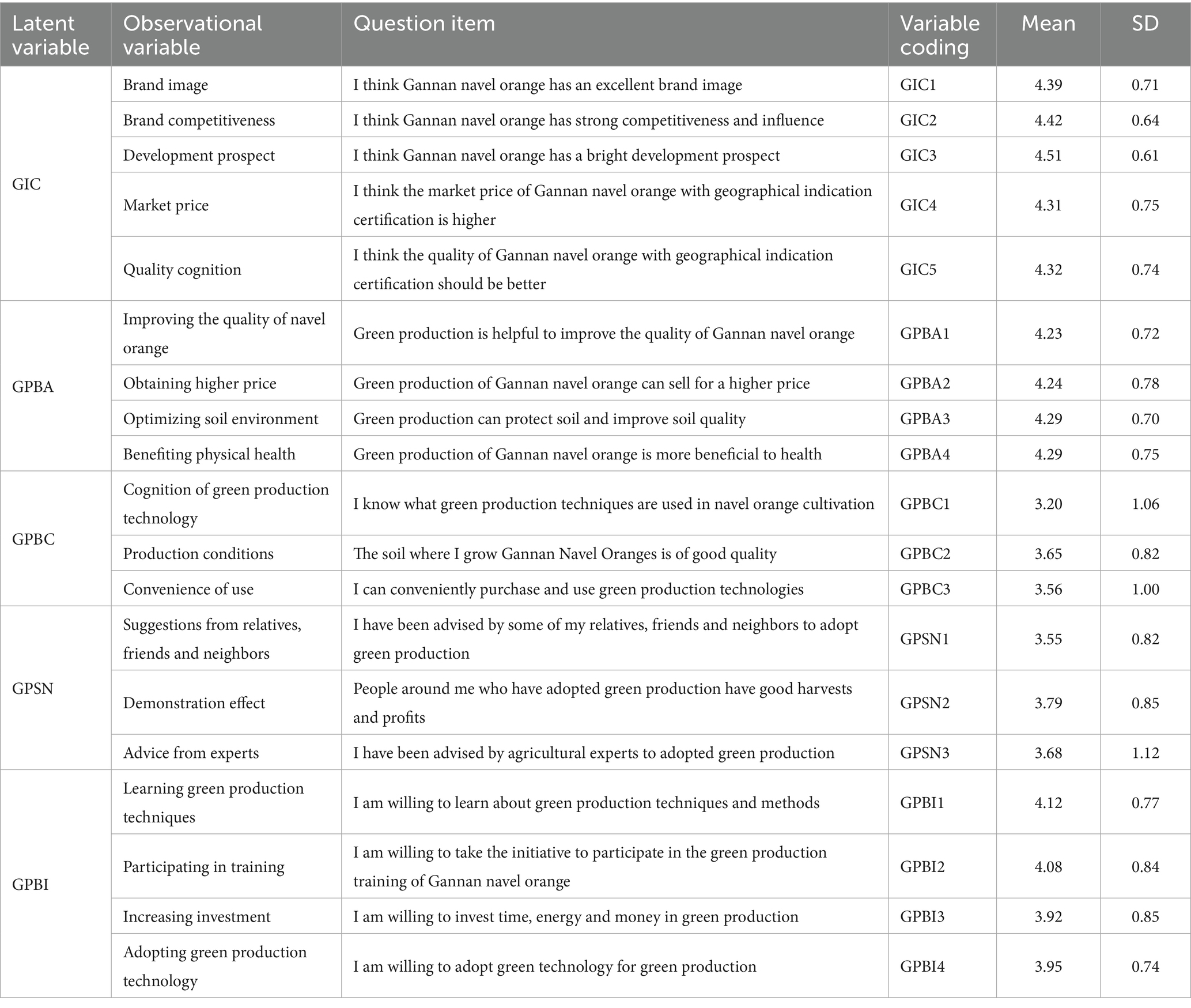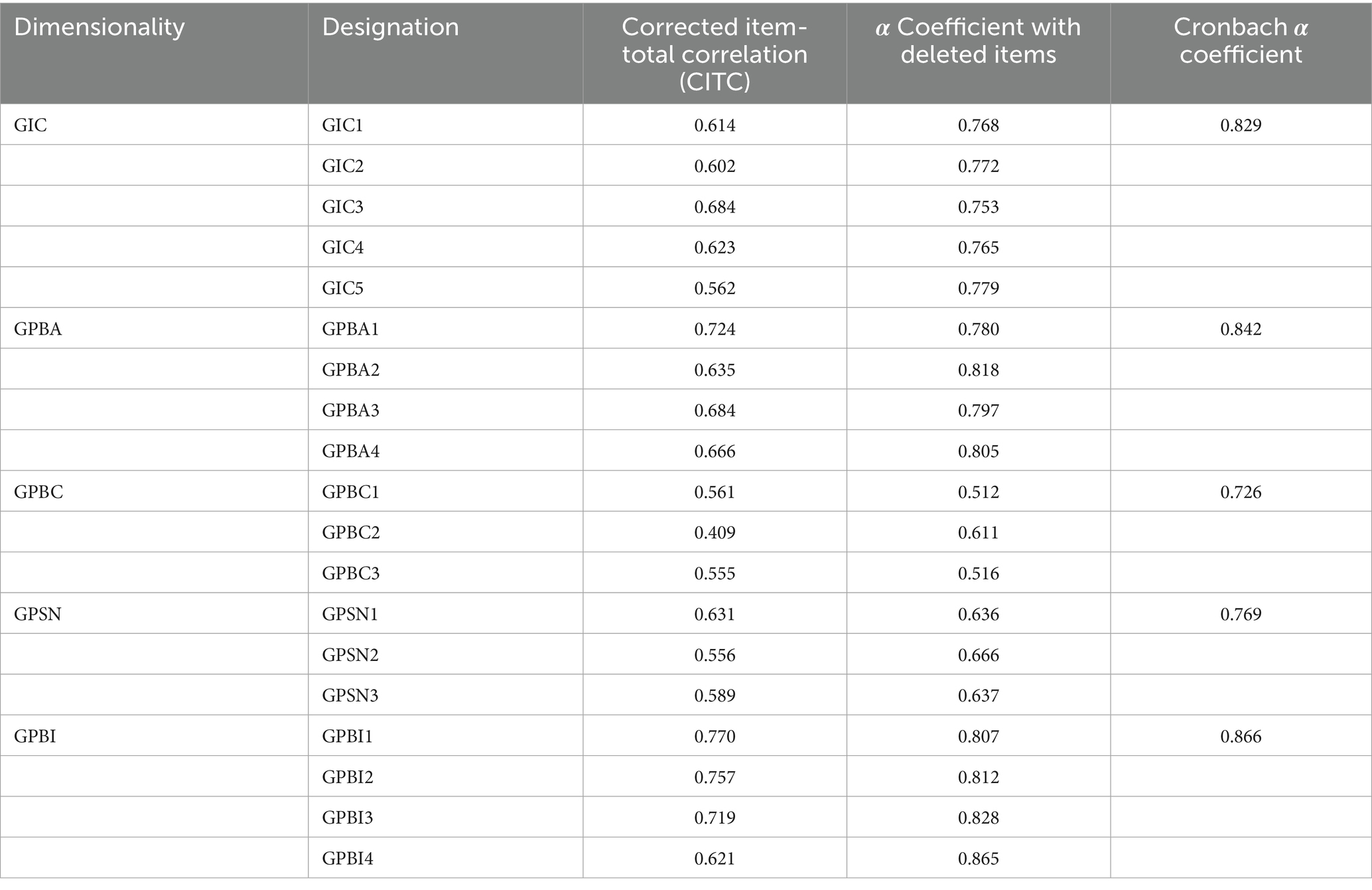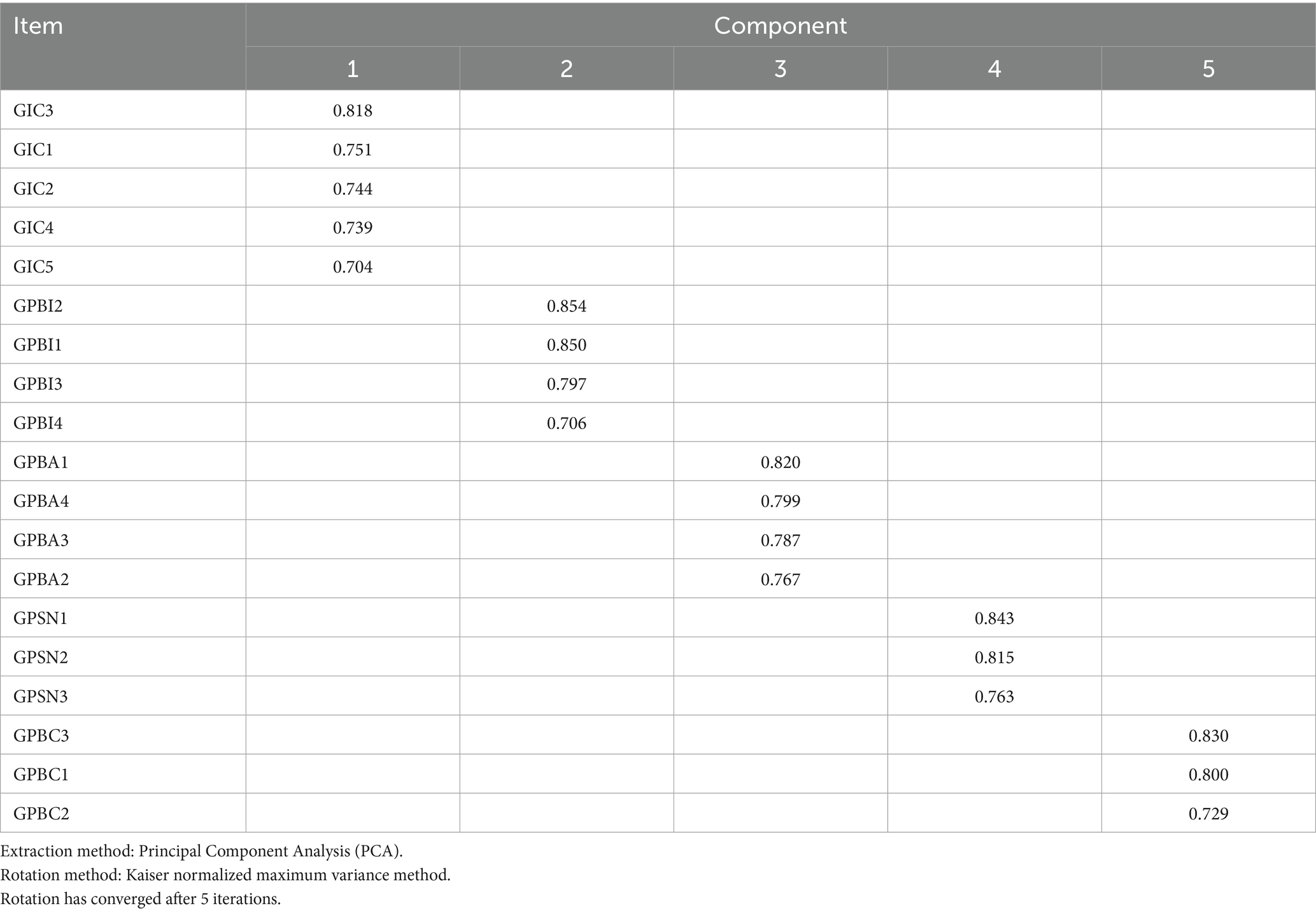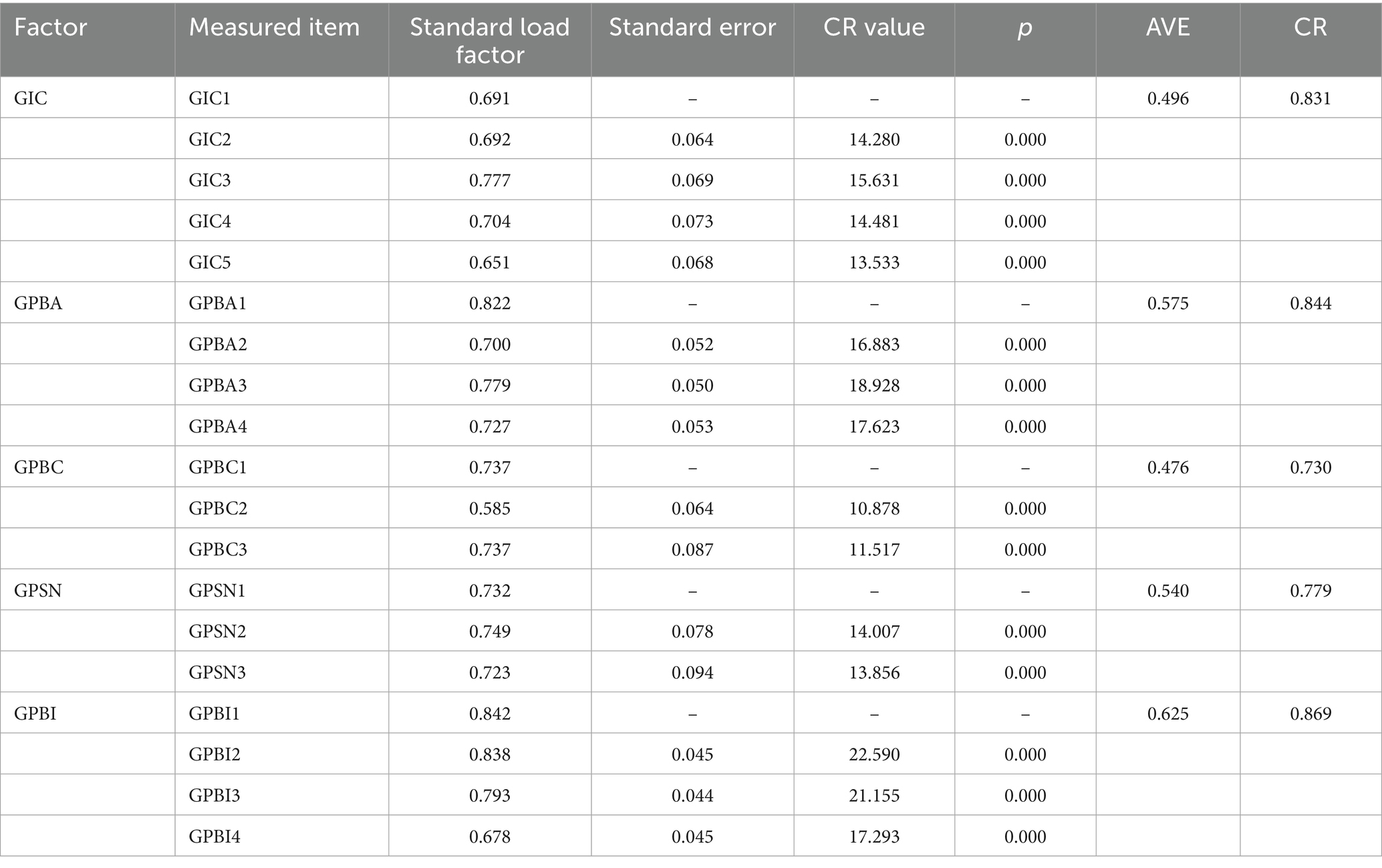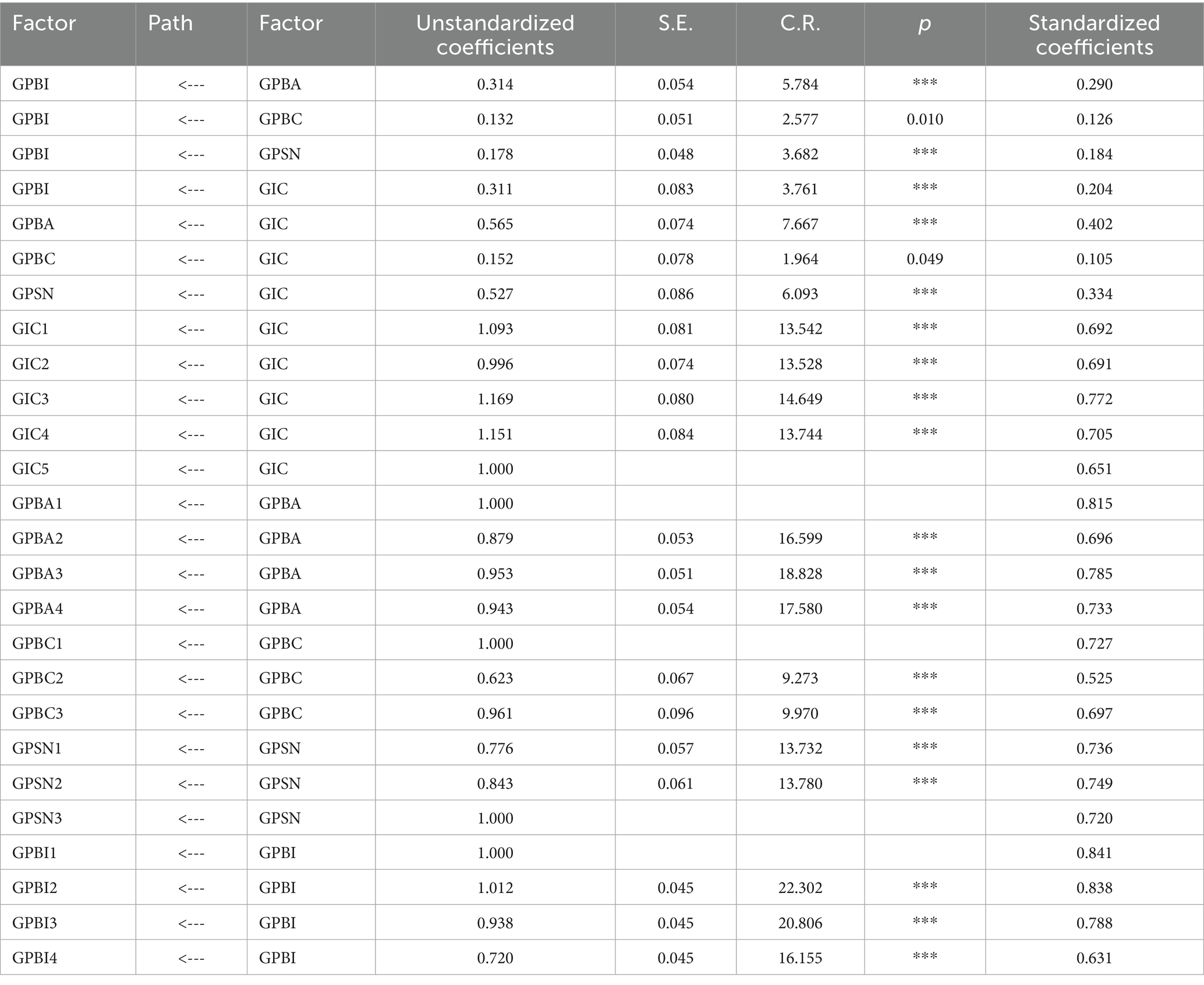- 1School of Economics and Management, Jiangxi Tourism and Commerce Vocational College, Nanchang, China
- 2School of Digital Economics, Jiangxi University of Finance and Economics, Nanchang, China
Geographical indication of agricultural products is not only a distinct symbol of local characteristic agriculture, but also a powerful engine for promoting high-quality agricultural development and facilitating rural revitalization. Exploring the mechanism by which farmers’ cognition of geographical indications affects their willingness for green production can help identify the fundamental path to maintaining the unique qualities of geographical indication agricultural products at the farmer level. Drawing upon the theory of planned behavior, this study establishes a theoretical framework of the impact of farmers’ geographical indication cognition on their willingness to engage in green production. Using the survey data collected from farmers in Xinfeng and Anyuan counties of Jiangxi Province, China, and the structural equation modeling to test the theoretical model, the conclusions are as follows: (1) Farmers’ attitudes towards green production, perceived behavioral control, and subjective norms significantly affect their intentions to adopt green production practices. Among these, the attitude towards green production has the most substantial impact, followed by subjective norms and perceived behavioral control. (2) Additionally, farmers’ geographical indication cognition directly positively influences their willingness to implement green production. (3) This cognition also positively influences their behavioral attitude, behavioral control, and subjective norm regarding green production, thereby indirectly shaping their green production behavioral intention, and the influence is ranked as follows: behavioral attitude, subjective norm, and behavioral control.
1 Introduction
As the characteristic agricultural products of a specific region, geographical indication agricultural products (GIAP) not only carry the regional brand and cultural symbols, but also significantly contribute to rural economic and high-quality development of agriculture. As global consumers’ concerns about food safety and the ecological environment increase, green production of GIAP not only enhances quality and safety to meet market demands but also aids in soil environment protection ensure the product quality characteristics. Farmers’ green production behavior means that farmers adopt eco-friendly and resource-saving production methods to minimize environmental harm and promote sustainable agricultural development. In recent years, the Chinese government has issued and implemented documents such as the “14th Five-Year Plan for Green Agricultural Development” to promote green production technologies. However, encouraging farmers to adopt these practices remains a challenge. The behavior still encounters the challenge of inadequate endogenous motivation (Wen et al., 2024).
GIAP, recognized for their significant brand value (Kong et al., 2008), can command a premium from consumers. This premium, in turn, can contribute to increase farmers’ income (Li et al., 2024), as evidenced by the promotion of local farmers’ income through brand premium and the stimulation of agricultural industry agglomeration and related industries development, as well as the regional heterogeneity in the impact due to varying government support and market conditions. However, at the same time, GIAP are governed by strict regulations on the environmental conditions, production quality and safety technical specifications. They also exhibit characteristics such as regional monopoly, unique quality, shared property rights, and shared usage (Liu, 2024). Due to the great economic value brought by the geographical indication (GI) brand and the public goods attribute of GIAP, farmers frequently overuse land resources during the production process in order to enhance product yields. In the long run, this will lead to the destruction of land resources, the disappearance of regional advantages, and the deterioration of the unique qualities of GIAP. Since farmers are not only rational economic beings but also have social attributes, It is crucial to explore the factors affecting the green production behavioral intention (GPBI), as empirical studies have shown that farmers’ green production behavior is influenced by a range of factors including individual characteristics, household characteristics, policy factors, and economic factors.
The Theory of Planned Behavior (TPB), proposed by Ajzen (1991) is a psychological framework used to understand decision-making and explain individuals’ actions in specific situations (Shi et al., 2020). It is rooted in the Theory of Reasoned Action (TRA), introduced by Ajzen and Fishbein. Ajzen identified that people’s behavior is not completely voluntary and is influenced by external factors. As a result, TPB proposed that individual behavior is governed by three main factors: attitude toward the behavior, perceived behavioral control and subjective norm (Ajzen, 1991). While TPB accounts for much of behavior, it falls short in analyzing green production by GIAP. GIAP are distinguished from ordinary agricultural products by factors such as market value, brand image, development prospects, and product quality, farmers’ geographical indication cognition (GIC) in these aspects may have an impact on their production decisions. Moreover, the failure of many countries to achieve the expected results in protecting geographical indications (GIs) can be largely attributed to the lack of GIC among producers, especially small farmers (Zhao and Luan, 2021). Hence, incorporating GIC factors into the Theory of Planned Behavior (TPB) is essential to investigate the GPBI of farmers producing geographical indication agricultural products (GIAP).
Regarding farmers’ GPBI, scholars have yielded significant research findings in areas like individual differentiation (Sun and Li, 2024), ecological cognition (Yu et al., 2024; Hair et al., 2019), government oversight (Wang and Zhang, 2024), risk awareness (Yin et al., 2022), and cooperative involvement (Jiang and Zhao, 2024). On the basis of TPB, some studies have also integrated Norm Activation Model (NAM) (Zhang et al., 2023; Xu et al., 2024) economic rationality (Shi et al., 2020), health concept (Ataei et al., 2021), pesticide knowledge (Bagheri et al., 2019), environmental values (Shi et al., 2020) and other factors. GI is widely recognized for its potential to encourage green production among farmers. For example, Zhang and Huang (2022) argued that GI brand construction can effectively communicate market information about agricultural products, promote farmers’ adoption of green production practices, and affect product quality and safety mainly through brand premium and brand maintenance. The study conducted by Baoerjiang et al. (2024) and Du et al. (2023) demonstrated that product quality certification can markedly enhance farmers’ adoption of green production technology. Belletti et al. (2015) and Marescotti et al. (2020) believed that the introduction of GI can improve producers’ awareness of the interrelationship between their products and the local environment, as evidenced by the success of GI in enhancing product value and protecting unique characteristics, such as those seen in the renowned French Charolais Beef and Italian Vitellone Bianco dell’Appennino Centrale, which leverage their specific natural environments. Li et al. (2021) suggested that farmers’ involvement in e-commerce within GI-protected areas could accelerate the integration into the development process of modern agriculture, promote a shift in agricultural management strategies, and heighten their sensitivety to green production practices; Li et al. (2021) believed that the production of GIAP should jointly abide by production standards and behavioral norms, which will encourage farmers to adopt green production behaviors. Nonetheless, current academic research predominantly focuses on external factors like production regulations and market incentives, with scant exploration of green production in GIAP from the farmers’ internal perspective.
This paper introduces cognitive factors influencing farmers’ attitudes toward GIAP based on TPB. It develops a theoretical model to examine internal factors affecting farmers’ GPBI, using the research data of Gannan navel orange in Xinfeng and Anyuan counties of Jiangxi Province, verified through structural equation modeling (SEM). This paper aims to explore the underlying logic of enhancing the GPBI in GIAP, focusing on strategies to maintain the unique soil environment and product quality through the implementation of soil protection measures.
2 Theoretical framework and research hypothesis
2.1 Green production behavioral attitude (GPBA) and GPBI
GPBA reflects farmers’ subjective view on green production behaviors. The more positively farmers evaluate green production behaviors, the stronger their intention to engage in green production behaviors (GPBI) is, and vice versa (Cheng et al., 2021). Based on the rational smallholder theory, farmers’ attitudes towards GPBA are closely tied to personal motives and interests. When farmers anticipate that green production practices can bring about compounding benefits, such as ecological improvement, improved product quality, and enhanced market competitiveness, they will develop a positive attitude and foster the intention to engage in green production. Based on this, hypothesis H1 is proposed.
H1: GPBA has a positive impact on GPBI.
2.2 Green production behavioral control (GPBC) and GPBI
Perceived behavioral control reflects farmers’ self-assessment of their ability to adopt green production behavior and the extent of their resource control. According to the Self-Efficacy Theory, the greater the farmers’ abilities and access to opportunities, the stronger their positive self-efficacy will be (Chen et al., 2024). That is, when farmers believe they have the technical capabilities, production conditions and easy access to the necessary resources for implementing green production practices, their confidence will increase, and their behavioral control beliefs will be effectively transformed into Green Production Behavior Intention (GPBI). Based on this, hypothesis H2 is proposed.
H2: GPBC has a positive effect on GPBI.
2.3 Green production subjective norm (GPSN) and GPBI
GPSN reflects the policy constraints and social pressures imposed by both the government and society when farmers implement green production. Farmers are inclined to develop a favorable GPBI when they observe heightened government support and broader societal acceptance of green production. Additionally, rural areas are typical “acquaintance societies,” and the network resources of farmers are mainly formed based on kinship and geography (Chen and Zhu, 2022), so the suggestions of relatives, neighbors, and the practices of those around them significantly influence farmers’ decision-making. When farmers perceive widespread green production, they tend to converge their behaviors to gain group recognition and support. Therefore, GPSN will have a positive impact on GPBI. Based on this, hypothesis H3 is proposed.
H3: GPSN has a positive impact on GPBI.
2.4 GIC and GPBI
According to the Cognition and Behavior Theory (CBT), an individual’s cognition affects his or her emotions and behaviors. GI is a regional quality certification mark that reflects the uniqueness of products produced in a specific geographical area in terms of quality, reputation, nature and humanity. When farmers possess a higher level of GIC, they will be more able to better comprehend and appreciate the value, encompassing product quality, development potential, and brand reputation. At this point, farmers may realize the importance of green production to maintain the soil environment, ensure product quality, preserve brand advantages, and thereby foster positive attitudes and expectations, ultimately enhancing their GPBI. At the same time, Farmers with a higher GIC are more likely to recognize the importance of green production for the sustainability of GIAP, so they are more motivated to proactively learn about green production technologies and assess their own resources and capabilities, thereby contributing to the enhancement of GPBI. In addition, GI serves as a quasi-public property right, shared and developed collectively by all regional members. Collective actions are needed to ensure the product quality of GIAP (Huang and Geng, 2022). Aware of this, farmers will pay more attention to others’ expectations and norms regarding green production practices, and be socially constrained to uphold the reputation of GIAP (Figure 1).
Based on the preceding arguments, this paper presents the following research hypotheses:
H4: GIC has a positive impact on the GPBI.
H5: GIC has a positive impact on the GPBA, GPBC, and GPSN.
H6: GIC indirectly affects GPBI through GPBA, GPBC and GPSN.
3 Methods
3.1 Data and descriptive statistics
3.1.1 Data
Located in the southern part of Jiangxi, Ganzhou, also known as South Jiangxi, governs 18 counties and boasts an expansive mountainous area of 45.6 million acres, of which about one-tenth is suitable for fruit tree cultivation. As a result, it has earned the title of ‘World Orange Town’ and ‘China Navel Orange Hometown’. Xinfeng County and Anyuan County, situated in the middle and southeast of Ganzhou, respectively, are key producing areas of navel orange in southern Jiangxi. As of 2023, Xinfeng County, with a navel orange planting area of 280,000 mu, contributes 260,000 tons to China’s production, ranking it as the second-largest producer in Ganzhou City. Anyuan County, with 270,000 mu, follows closely with 210,000 tons, securing the third position in the city’s production hierarchy. Xinfeng County, renowned as the birthplace of Gannan navel orange, is acclaimed as the world’s premier navel orange production hub and China’s sole demonstration area for navel orange standardization. Anyuan County serves as the core producing area in southern Jiangxi and the largest distribution center of navel orange in China (Figure 2).
The data are based on a questionnaire survey of navel orange growers in Xinfeng and Anyuan counties of Ganzhou City, Jiangxi Province from July to September 2023. The survey assessed the planting areas, acreage, and yield of navel oranges in two locations by combining systematic sampling with random sampling. In each county, four to five townships were selected, followed by three to four sample villages within each township and about 15–20 navel orange growers were randomly selected as the survey participants. The questionnaire gathered data on individual family characteristics, farming situations, GIC, GPBI, and other relevant factors of the farmers. A total of 588 questionnaires were distributed, yielding 571 valid responses after excluding invalid ones, resulting in an effective response rate of 97.11%.
3.1.2 Descriptive statistics
In the sample, at the individual level, the production decision-makers of rural households were mainly male. The average age of farmers was 54.09 years, indicating that the local navel orange cultivation was mainly undertaken by older individuals. The mean value of education level was 2.99, suggesting that most respondents were at the junior high school literacy level. The average health condition score was 1.15, reflecting overall good health. The mean value for village cadre involvement was 0.14, indicating that the majority of farmers had not served as village cadres. The mean value for receiveing agricultural training was 0.73, suggesting that most respondents had participated in agricultural training, with local technical training being relatively widesread. Furthermore, 56% of farmers in the sample reported using geographical indications, indicating that most people have used the “Gannan Navel Orange” geographical indication. At the household level, the average number of family members engaged in farming was 2.49, implying that quite a few households had two generations involved in farming simultaneously. The average planting scale of navel oranges was 34.22 mu, with a large standard deviation, indicating the survey sample covered small, medium and large-scale growers. Farmers had an average of 13.95 years of planting experience, suggesting that the development of navel oranges in southern Gannan is relatively stable, with continuous cultivation practices among farmers. The average soil quality score was 3.65, indicating generally good soil conditions, while the average planting terrain score was 3.82, suggesting favorable planting terrain, and these results further demonstrate that the southern Gannan region of Jiangxi Province is well-suited for navel orange cultivation. Detailed information is provided in the Table 1.
3.2 Variable selection
In this paper, green production refers to the adoption of environmentally friendly and sustainable production methods in the cultivation of GIAP, with the core objectives of protecting the ecological environment, conserving resources, and enhancing the quality and safety of agricultural products. It aims to promote the simultaneous improvement of both ecological and social benefits in agricultural production. In the cultivation of navel oranges, green production encompasses various practices. In soil, fertilizer and water management, “farmyard manure, straw soil ripening,” “intercropping or grass planting,” “straw mulching,” “organic fertilizers,” “soil testing and targeted fertilization” and “clean water irrigation” are included. In tree management, practices such as “regular pruning and shaping,” “flower thinning and fruit retention,” “manual fruit thinning” and “bagging fruit.” In pest and disease control, methods involve “agricultural control,” “physical treatment control,” “biological control,” “biological pesticides” and “farmyard manure for weed control” and so on.
According to the above theoretical analysis, considering the actual circumstances of navel orange farmers in the study area, the questionnaire was formulated by referring to Liu et al. (2021), encompassing five latent variables: GIC, GPBA, GPBC, GPSN, and GPBI, alongside 19 observational variables (Liu et al., 2021), GIC includes five aspects: brand image, brand competitiveness, development prospect, market price and quality cognition. GPBA includes four aspects: improving the quality of navel oranges enhances their price, optimizes the soil environment, and benefits physical health. GPBC encompasses three aspects: cognition of green production technology, suitable production conditions, and ease of use. The GPSN comprises suggestions from relatives, friends, and neighbors, the demonstration effect, and advice from experts. GPBI covers four aspects: learning green production techniques, participating in training sessions, increasing investments, and adopting green production technology. The questionnaire utilized a five-point Likert Scale, with responses ranging from 1 (strongly disagree) to 5 (strongly agree). The specific meanings and definitions of measurement variables are detailed in Table 2, providing a comprehensive understanding of each variable’s role and measurement method.
3.3 Model and design
3.3.1 Model
This paper used a SEM to verify the factors influencing GPBI. Structural equation modelings are designed to explore causal relationships and latent structures between variables. It can simultaneously consider both observed and latent variables, and describe their relationships by establishing multiple equations. With the help of SEM, one can assess the model fit, parameter estimation, and hypothesis testing, thereby verifying the relationships between variables. The matrix equation expression of the SEM is as follows:
Equations 1–3 represent the measurement models, which illustrate the relationships between exogenous latent variables and their corresponding observable variables, as well as between endogenous latent variables and observable variables. ξ denotes the exogenous latent variables, which refer to GIC, GPBA, GPBC and GPSN; X represents the observed variables corresponding to ξ, which reflect the GIC, GPBA, GPBC and GPSN. is the coefficient matrix of the strength of the relation between X and ξ, δ is the measurement error of X. η represents the endogenous latent variable, indicating the GPBI; Y is the observed variable corresponding to η, which is an indicator of GPBI; is the coefficient matrix of the strength of the relationship between Y and η, ε is the measurement error of Y. (3) is a structural model, and β represents the coefficient matrix of endogenous latent variables, Γ represents the coefficient matrix of exogenous latent variables, ζ is the random error term of the structural model.
3.3.2 Design
The collected data were processed and analyzed using SPSS 26.0 and AMOS 26.0. Before applying the SEM model, it is essential to assess the effectiveness and consistency of the scale to verify its validity and reliability. The higher the reliability and validity of the questionnaire, the smaller the measurement error. First, Cronbach’s alpha was used to measure the reliability of items across different dimensions. Next, factor analysis was conducted to perform the KMO (Kaiser-Meyer-Olkin) test and Bartlett’s test of sphericity, which were used to analyze the validity of the questionnaire, and determine the number and distribution of the observed variables’ factors. Additionally, in order to ensure the good fit between the model and the data, and to ensure the reliability and accuracy of the validity tests, the suitability of the constructed model was examined. Confirmatory factor analysis (CFA) was used to evaluate the structural validity of the questionnaire. Following this, discriminative validity analysis was performed to examine the distinctions between the factors. Finally, SEM was employed to evaluate the model’s fit, parameter estimation, and hypothesis testing, thereby verifying the relationships and underlying mechanisms between the variables.
4 Results
4.1 Reliability analysis
In the reliability test of projects with different dimensions, the determined reliability values were as follows: GIC exhibited a reliability value of 0.829, GPBA reached 0.842, GPBC had a value of 0.726, GPSN scored 0.769, and GPBI achieved a reliability value of 0.866. These reliability coefficients, indicating the internal consistency of the measurement tool, were deemed acceptable as they were at or above the commonly accepted threshold of 0.7 (Table 3).
4.2 Factor analysis
4.2.1 Explore factor analysis
After importing the data into SPSS, we conducted a validity analysis using the KMO and Bartlett’s Spherical Test. The KMO value of 0.848 and the chi-square value of 4,380.560 from Bartlett’s test, with 171 degrees of freedom and a significance level of 0.000, suggest that the data is suitable for factor analysis, meeting the validity criteria. After performing factor rotation using the maximum variance method on the variable items and excluding those with factor loading coefficients below 0.5, the final factor distribution is presented in Table 4. According to the distribution interval characteristics of factors, the five factors can be labeled as GIC, GPBA, GPBC, GPSN, and GPBI (Liang et al., 2007).
4.2.2 Confirmatory factor analysis
Confirmatory Factor Analysis (CFA) was performed to evaluate the structural validity of the questionnaire. To assess the goodness-of-fit of the proposed model, the fitting index suggested by Marsh et al. (2004) was adopted in this study.
The χ2/df value of the validation factor model was 2.527, along with other fit indices such as GFI at 0.923, AGFI at 0.903, RMSEA at 0.052, NFI at 0.895, RFI at 0.901, CFI at 0.933, and PNFI at 0.771. The PGFI was 0.726, suggesting all items’ fit values were within an acceptable range. According to the confirmatory factor analysis on the questionnaire of this survey, the AVE values of the five dimensions of this survey were above 0.4, and the CR values of variables were above 0.7. The factor loading coefficients of different variables were all above 0.5, and the significance level of the items reached the standard below 0.05. In line with the established practice in the field, all items measured in this scale underwent rigorous testing through confirmatory factor analysis (CFA), a method widely recognized for its role in validating theoretical models and ensuring the accuracy of measurement tools (Table 5) (Beckett et al., 2018).
4.3 Discriminant validity
After conducting the discriminant validity analysis, the square root of the AVE value for the GIC factor was 0.704, exceeded the highest absolute value of the inter-factor correlation coefficients at 0.332, indicating good discriminant validity. Similarly, the square root of the AVE for the GPBA factor was 0.758, higher than the maximum absolute value of the inter-factor correlation coefficient, 0.384, suggesting strong discriminant validity. For the GPBC factor, the square root of the AVE was 0.690, which was greater than the highest absolute value of the inter-factor correlation coefficients, 0.289, confirming good discriminant validity. The square root of the AVE for the GPSN factor was 0.735, which surpassed the maximum absolute value of the inter-factor correlation coefficients, 0.306, indicating good discriminant validity. Finally, the square root of the AVE for the GPBI factor was 0.791, exceeding the highest absolute value of the inter-factor correlation coefficients, 0.384, demonstrating its strong discriminant validity (Table 6).
4.4 Structural equation model analysis
After analysis, the fitting indicators of the variables were determined, and a revised model was obtained with a χ2/df value of 2.522. Other adaptation indicators include were 0.935 for GFI, 0.914 for AGFI, 0.052 for RMSEA, 0.917 for NFI, 0.901 for RFI, 0.948 for CFI, 0.772 for PNFI, and 0.709 for PGFI. Given that all model fitting values were above 0.9, it indicates a strong model fit, as values closer to 1 suggest a better fit according to statistical standards (Figure 3).
Path analysis indicated that the influence coefficients of GPBA, GPBC, and GPSN on GPBI were 0.290, 0.126, and 0.184, respectively. This means that when GPBA, GPBC, and GPSN each increase by one unit, GPBI correspondingly increases by 0.290, 0.126, and 0.184 units, respectively. Therefore, GPBA, GPBC, and GPSN have a significant positive impact on GPBI, assuming that Hypotheses 1, 2, and 3 are all valid. The impact coefficient of GIC on GPBI was 0.204, indicating that GIC has a significant impact on GPBI and hypothesis 4 is valid. The standardization coefficients of GIC for GPBA, GPBC, and GPSN were 0.402, 0.105, and 0.334, respectively. Therefore, GIC has a significant positive impact on GPBA, GPBC, and GPSN, making Hypothesis 5 valid.
From the perspective of specific factors, the factor loading coefficients for GIC were ranked as follows: development prospect (0.772), market price (0.705), brand image (0.692), brand competitiveness (0.691), and quality cognition (0.651). This suggests that farmers’ GIC hinges on their expectations for the future development and potential market price increase of the GIAP. For GPBA, the coefficients were ranked as follows: improving the quality of navel orange (0.815), optimizing soil environment (0.785), benefiting physical health (0.733) and achieving a higher price (0.696), thereby highlighting farmers’ GPBA focus on green production to enhance product quality and soil protection. The reason why obtaining higher price was ranked last may be that farmers do not have an obvious perception that green production can make Gannan navel oranges sell at a higher price. In terms of GPBC, cognition of green production technology (0.727), convenience of use (0.697) and production conditions (0.525) were ranked in order by coefficient, which indicates that farmers’ GPBC should focus on strengthening farmers’ training on green production technology and making it easy to obtain and use. In the GPSN, the coefficients were ranked as follows: demonstration effect (0.749), suggestions from relatives, friends, and neighbors (0.736), and advice from experts (0.720), which suggests that farmers attach greater importance to the demonstration effect of those around them and their suggestions from relatives, friends and neighbors (Table 7).
4.5 Indirect effect analysis
In the analysis of the mediating effect of variables, AMOS23.0 was used to analyze the indirect effects. The syntax was set up as follows: M1: GIC → GPBA → GPBI, M2: GIC → GPBC → GPBI, M3: GIC → GPSN → GPBI. Bootstrap method was used to analyze the path for 5,000 iterations, and a 95% variable confidence interval was extracted. The analysis showed that the confidence interval of M1: GIC → GPBA → GPBI was [0.074–0.332]. M2: the confidence interval of GIC → GPBC → GPBI was [0.003–0.070]. M3: the confidence interval of GIC → GPSN → GPBI was [0.023–0.189]. Therefore, the mediating effects of the three paths have been confirmed, and a partial mediating relationship is shown in the analysis. The ranking of the mediating effects is M1 > M3 > M2, indicating that the path from GIC to GPBI through GPBA is the most significant. Therefore, hypothesis 6 is established (Table 8).
5 Discussion
This paper introduced GIC based on the Theory of Planned Behavior (TPB), constructed a theoretical framework and discussed the influencing factors of GPBI with GIAP from the internal level of farmers. The results confirmed the beneficial effect of GIC on GPBI involving GIAP, demonstrating the applicability of TPB to this research area. To enhance GPBI through GIAP and promote green production among farmers, thereby ensuring product quality and maintaining market competitiveness, interventions are necessary. These should be carried out in the following aspects:
The publicity for GIAP should be increased to improve farmers’ GIC. According to the research results, the core of GIC is influenced by farmers’ anticipation of the future growth of GIAP and the potential for GIAP to yield increased market prices. Therefore, in the process of government publicity, special attention should be paid to letting farmers fully aware of the value and importance of GIAP, so that they have a good expectation for the future development of GIAP, which can also bring better economic benefits for them.
The GPBA of farmers holds a crucial position in the GPBI, necessitating the reinforcement of farmers’ GPBA via education and training programs. Research results indicate that within the GPBA, farmers are primarily concerned with how green production can enhance product quality and benefit soil protection. Hence, in the process of education and guidance, the government ought to emphasize the correlation between green production of GIAP and improved product quality. Green production not only contributes to the protection of soil quality and the reduction of chemical pollution but also ensures the sustainable production of GIAP with unique quality. Additionally, considering the varying education levels of farmers in different counties and regions, tailored educational efforts should be made we can increase educational investment for farmer with lower levels of formal education and further popularize knowledge and technical training on sustainable agricultural practices and green production methods.
Establish models and demonstration projects to foster interactions and collaboration among farmers. Rural areas are “acquaintance society,” which is also confirmed in the research results of this paper. Within the GPSN framework, farmers prioritize the demonstrative impact of green production practices adopted by their peers, as well as advice from relatives, friends, and neighbors. Therefore, in regions producing GIAP, efforts should focus on establishing demonstration households and exemplary models to form a supportive environment for the adoption of green production technologies. Organizing experience-sharing activities among farmers can further enhance their awareness and ability of green production. For older farmers in particular, exemplary projects and recommendations from friends and family can help overcome their resistance to new technologies.
Strengthen the formulation and implementation of agricultural policies and provide farmers with necessary resources and technical support. According to the research results, in the GPBC, farmers place greater emphasis on the cognition and convenient access to green production technology. Therefore, it is essential to formulate corresponding agricultural policies to provide farmers with continuous training and guidance on green production technology, as well as ensuring convenient access to green production tools and techniques and green production inputs through agricultural social services. Especially for small-scale farmers, increased technical support should be provided to help them overcome scale constraints and promote their green production behavior.
Compared with other similar research results (Liu et al., 2021), the total effect of GI cognition on green production in this study is relatively low. A possible reason for this may be the low proportion of farmers in the survey sample who have experience with GI use, and the farmers’ understanding of GI has not been fully developed. Furthermore, when designing the model in this study, technical capability indicators should have been incorporated into the GPBC to obtain more accurate evaluation results. Due to the limited length of this article, there are certain limitations in this research. Firstly, the model design did not include a subgroup analysis of the specific situation in the two counties, which prevented an understanding of the differences between farmers in the two counties, thus hindering the formulation of localized policies. Secondly, the data sample in this study was based on Gannan navel oranges, which is more applicable to crop-based GI agricultural products, but may have limited reference for livestock and poultry-based GI products. Moreover, due to the constraints of the survey conditions, the data were only collected from Xinfeng and Anyuan counties in Ganzhou. Although these two counties are somewhat representative, the sample size remains small compared to the production of Gannan navel oranges across all counties in Ganzhou. In the future, expanding the survey scope would enhance the generalizability and persuasiveness of the results. Additionally, future research could incorporate more GI-related indicators, such as production regulations and government governance of GIs, into the research framework, in order to better identify beneficial measures that promote the sustainable development of GIAP.
6 Conclusion
Drawing upon the Theory of Planned Behavior (TPB), this article introduces cognitive factors and analyzes survey data collected from farmers in Xinfeng and Anyuan counties of Ganzhou, Jiangxi Province. Through the use of AMOS software and SEM, it explores the influencing factors of the willingness to engage in green production (GPBI). The results indicated that: (1) Farmers’ attitudes towards green production (GPBA), perceived behavioral control (GPBC), and subjective norm of green production (GPSN) all have a positive impact on their intention to green production (GPBI), with GPBA having the largest effect, followed by GPSN, and then GPBC. (2) Farmers’ cognition of geographical indication (GIC) positively impacts their willingness to implement green production (GPBI). (3) GIC can positively promote farmers’ attitudes towards green production (GPBA), perceived behavioral control (GPBC), and social norms regarding green production (GPSN), and indirectly affect their intention to adopt green production practices (GPBI). The order of the effects, based on these three factors, is as follows: GPBA, GPSN, and GPBC.
Data availability statement
The data that support the findings of this study are available from the corresponding author upon reasonable request.
Author contributions
QL: Writing – original draft. HL: Writing – review & editing, Funding acquisition. XS: Data curation, Methodology, Writing – review & editing.
Funding
The author(s) declare that financial support was received for the research and/or publication of this article. This study was supported by the National Natural Science Foundation of China (No. 72363014; 42401324); National Social Science Foundation of China (No. 20BJY144); Humanities and Social Science Foundation of Ministry of Education of China (No. 23YJCZH272; 24YJCZH175); Natural Science Foundation of Jiangxi Province (No. 20224BAB205048) and Basic Science (Natural Science) Foundation of Jiangsu Province (No. 22KJB630001).
Conflict of interest
The authors declare that the research was conducted in the absence of any commercial or financial relationships that could be construed as a potential conflict of interest.
Generative AI statement
The authors declare that no Gen AI was used in the creation of this manuscript.
Publisher’s note
All claims expressed in this article are solely those of the authors and do not necessarily represent those of their affiliated organizations, or those of the publisher, the editors and the reviewers. Any product that may be evaluated in this article, or claim that may be made by its manufacturer, is not guaranteed or endorsed by the publisher.
References
Ataei, P., Gholamrezai, S., Movahedi, R., and Aliabadi, V. (2021). An analysis of farmers’ intention to use green pesticides: the application of the extended theory of planned behavior and health belief model. J. Rural. Stud. 81, 374–384. doi: 10.1016/j.jrurstud.2020.11.003
Bagheri, A., Bondori, A., Allahyari, M. S., and Damalas, C. A. (2019). Modeling farmers’ intention to use pesticides: an expanded version of the theory of planned behavior. J. Environ. Manag. 248:109291. doi: 10.1016/j.jenvman.2019.109291
Baoerjiang, J. N. S. B. K., Li, J. H., and Lu, Q. (2024). Product quality certification and performance of farmers' adoption of green production technology. J. Arid Land Resour. Environ. 38, 32–43. doi: 10.13448/j.cnki.jalre.2024.222
Beckett, C., Eriksson, L., Johansson, E., and Wikstrom, C. (2018). “Multivariate data analysis (MVDA)” in Pharmaceutical quality by design: a practical approach, 201–225.
Belletti, G., Marescotti, A., Sanz-Canada, J., and Vakoufaris, H. (2015). Linking protection of geographical indications to the environment: evidence from the European Union olive-oil sector. Land Use Policy 48, 94–106. doi: 10.1016/j.landusepol.2015.05.003
Chen, M. R., Chen, Y., Xie, B. P., and Pei, T. T. (2024). Farmers' willingness to participate in the construction of agricultural canals and its influencing factors: a study from the perspective of planned behavior theory. J. Arid Land Resour. Environ. 38, 67–75. doi: 10.13448/j.cnki.jalre.2024.185
Chen, P. B., and Zhu, C. Z. (2022). Internet use, social capital and farmers’ health. J. Stat. Inf. 37, 99–109.
Cheng, Y., Zeng, W. Z., and Hu, Y. (2021). Analysis on influencing factors of farmers' willingness to participate in understory economy based on planned behavior theory. Rural Econ. 3, 62–69.
Du, S. X., Luo, X. F., Tang, L., and Yan, A. Q. (2023). The effects of quality certification on agricultural low-carbon production behavior: evidence from Chinese rice farmers. Int. J. Agric. Sustain. 21:2227797. doi: 10.1080/14735903.2023.2227797
Hair, J. F., Risher, J. J., Sarstedt, M., and Ringle, C. M. (2019). When to use and how to report the results of PLS-SEM. Eur. Bus. Rev. 31, 2–24. doi: 10.1108/EBR-11-2018-0203
Huang, B. K., and Geng, X. H. (2022). A study on the governance of opportunistic behavior of geographical indications agricultural producers: based on the perspective of collective action. Econ. Manag. 36, 19–26.
Jiang, L. K., and Zhao, W. (2024). Research on the induction path of cooperative participation on the transformation of farmers’ green production willingness behavior-taking organic fertilizer as an example to replace chemical fertilizers. Chin. J. Agric. Resour. Reg. Plan. 2, 1–15.
Kong, X. J., Su, Y. J., and Kong, Y. H. (2008). Countermeasures and thoughts on improving the economic benefit of geographical indication products in China. Econ. Res. Guid. 1, 161–163.
Li, X.J., Chen, Z., and Xia, X.L. (2021). Spatial spillover effects of participating in e-commerce on farmers' green production awareness-analysis based on the two-zone spatial Durbin model. Aust. J. Agric. Econ. 3:49–64. doi: 10.13246/j.cnki.jae.2021.07.004
Li, G. S., Zheng, J. L., and Ma, J. K. (2024). How can regional public branding of agricultural products promote farmers’ income? Chin. J. Agric. Resour. Reg. Plan. 11, 1–13.
Liang, H. G., Saraf, N., Hu, Q., and Xue, Y. J. (2007). Assimilation of enterprise systems: the effect of institutional pressures and the mediating role of top management. MIS Q. 1, 59–87. doi: 10.2307/25148781
Liu, J. (2024). Structural characteristics of geographical indication agricultural products in China. J. Arid Land Resour. Environ. 38, 79–86. doi: 10.13448/j.cnki.jalre.2024.143
Liu, Y., Li, D. L., and Yang, T. Z. (2021). Study on the influence of geographical indication cognition on farmers’ safe production-taking “Luochuan apple” in Shanxi as an example. Chin. J. Agric. Resour. Reg. Plan. 42, 209–216.
Marescotti, A., Quinones-Ruiz, X. F., Edelmann, H., Belletti, G., Broscha, K., and Altenbuchner, C. (2020). Are protected geographical indications evolving due to environmentally related justifications? An analysis of amendments in the fruit and vegetable sector in the European Union. Sustain. For. 12:3571. doi: 10.3390/su12093571
Marsh, H. W., Hau, K. T., and Wen, Z. L. (2004). In search of golden rules: comment on hypothesis-testing approaches to setting cutoff values for fit indexes and dangers in overgeneralizing Hu and Bentler's (1999) findings. Struct. Equ. Model. 11, 320–341. doi: 10.1207/s15328007sem1103_2
Shi, Z. H., Cui, M., and Zhang, H. (2020). Study on farmers' green production willingness based on expanded planning behavior theory. J. Arid Land Resour. Environ. 34, 40–48. doi: 10.13448/j.cnki.jalre.2020.64
Sun, Q. L., and Li, Z. Z. (2024). Effect of farmer differentiation and demonstration on farmers' intention and behavior of green agricultural production. J. Chin. Agric. Mech. 45, 279–288+319. doi: 10.13733/j.jcam.issn.2095-5553.2024.05.046
Wang, H. Q., and Zhang, L. (2024). Research on farmers’ low-carbon production behavior: introducing green cognition into the theory of planned behavior. Pol. J. Environ. Stud. 33, 873–884. doi: 10.15244/pjoes/172041
Wen, S. Y., Chen, Z., Xia, X. L., Zhang, J. Z., and Xie, S. H. (2024). Impact of digital agricultural technology promotion services on farmers' adoption of green production technologies. J. Arid Land Resour. Environ. 38, 43–52. doi: 10.13448/j.cnki.jalre.2024.203
Xu, Z. H., Meng, W. C., Li, S. Q., Chen, J., and Wang, C. W. (2024). Driving factors of farmers' green agricultural production behaviors in the multi-ethnic region in China based on NAM-TPB models. Glob. Ecol. Conserv. 50:e02812. doi: 10.1016/j.gecco.2024.e02812
Yin, L., Zhao, Z. Y., and Zhang, Y. W. (2022). Does the risk uncertainty perception affect agricultural green production on behavior? - evidence from the agricultural green development going-first area. J. Arid Land Resour. Environ. 36, 26–32. doi: 10.13448/j.cnki.jalre.2022.223
Yu, L. F., Cao, D. Y., and Liao, B. (2024). Research on the impact of livelihood capital and ecological cognition on farmers' willingness to adopt green technology. Chin. J. Agric. Resour. Reg. Plan. 12, 1–15.
Zhang, Y., and Huang, Y. Z. (2022). Research on the influence of geographical indication brand participation on the quality and safety of agricultural products. J. Huazhong Agric. Univ. (Soc. Sci. Ed.) 5, 123–135. doi: 10.13300/j.cnki.hnwkxb.2022.05.013
Zhang, R. Z., Tang, R. D., Yao, Y., Wang, Y. L., Shi, Y. T., Hua, Q., et al. (2023). Study on the willingness of large-scale farmers to produce green and high-quality agricultural products under TPB-NAM framework-based on survey data of Jiangsu Province. Chin. J. Agric. Resour. Reg. Plan. 44, 184–194.
Keywords: geographical indication cognition, green production behavioral intention, the theory of planned behavior, structural equation modeling, China
Citation: Liu Q, Lu H and Shi X (2025) The impact of geographic indication recognition on farmers’ intentions for green production behavior: a case study of Gannan navel oranges in China. Front. Sustain. Food Syst. 9:1598152. doi: 10.3389/fsufs.2025.1598152
Edited by:
Sandeep Poddar, Lincoln University College, MalaysiaReviewed by:
Fitriani Damayanti, Universitas Muhammadiyah Semarang, IndonesiaPijush Mallick, Srinath University, India
Guswarni Anwar, University of Bengkulu, Indonesia
Copyright © 2025 Liu, Lu and Shi. This is an open-access article distributed under the terms of the Creative Commons Attribution License (CC BY). The use, distribution or reproduction in other forums is permitted, provided the original author(s) and the copyright owner(s) are credited and that the original publication in this journal is cited, in accordance with accepted academic practice. No use, distribution or reproduction is permitted which does not comply with these terms.
*Correspondence: Hua Lu, bHVodWFuakAxMjYuY29t
 Qiong Liu1,2
Qiong Liu1,2 Hua Lu
Hua Lu